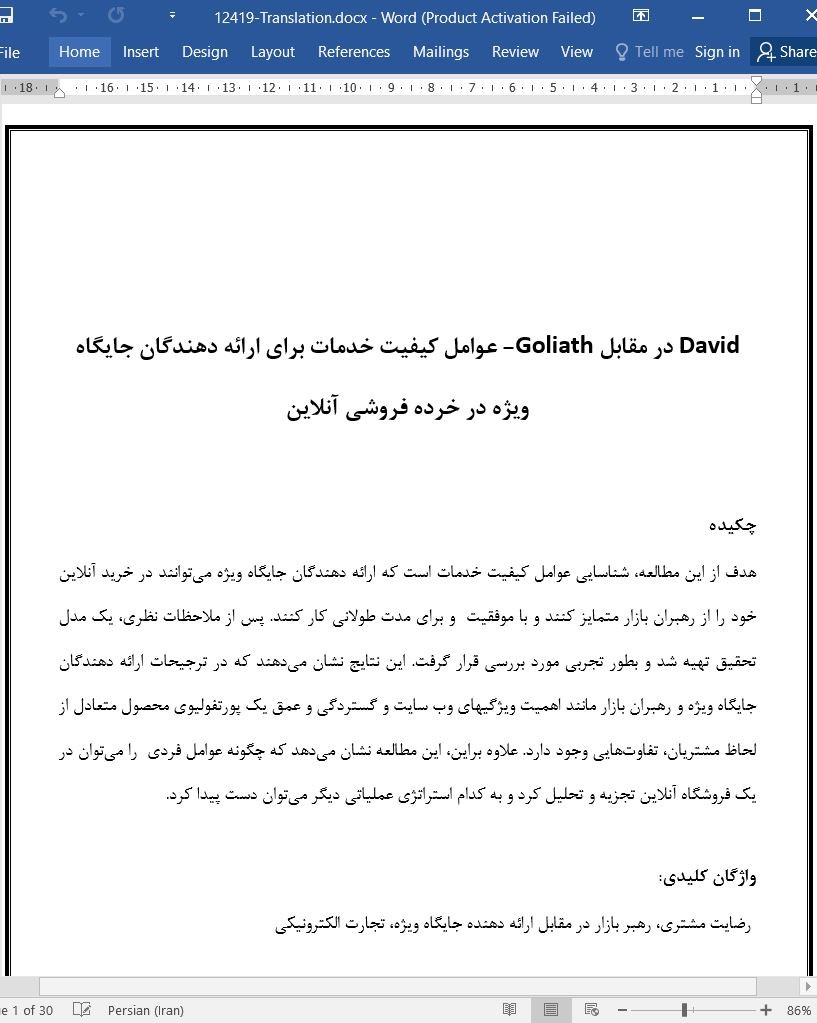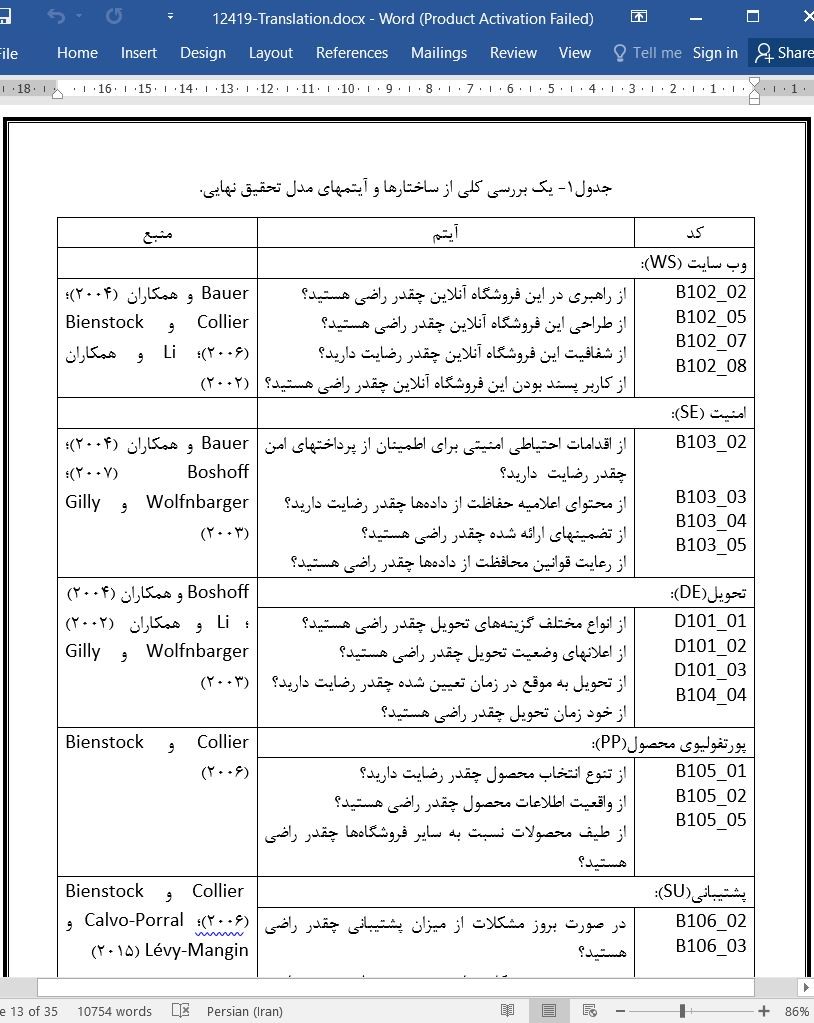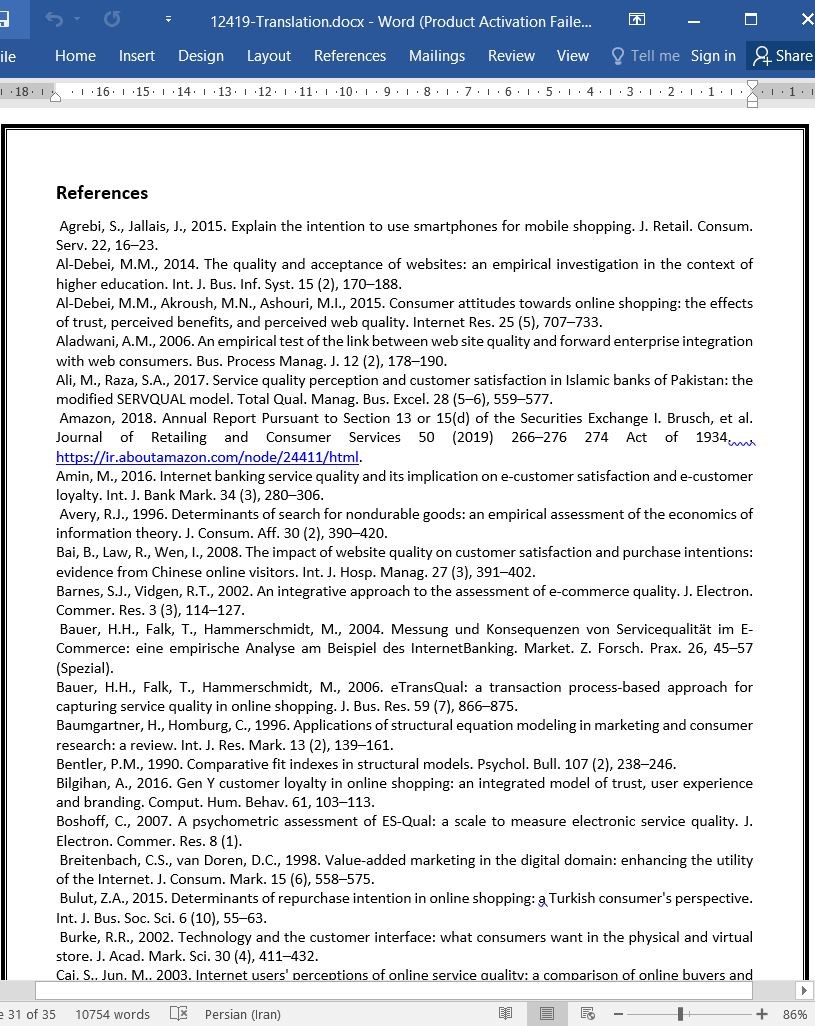
دانلود مقاله عوامل کیفیت خدمات برای ارائه دهندگان جایگاه ویژه در خرده فروشی آنلاین
چکیده
هدف از این مطالعه، شناسایی عوامل کیفیت خدمات است که ارائه دهندگان جایگاه ویژه میتوانند در خرید آنلاین خود را از رهبران بازار متمایز کنند و با موفقیت و برای مدت طولانی کار کنند. پس از ملاحظات نظری، یک مدل تحقیق تهیه شد و بطور تجربی مورد بررسی قرار گرفت. این نتایج نشان میدهند که در ترجیحات ارائه دهندگان جایگاه ویژه و رهبران بازار مانند اهمیت ویژگیهای وب سایت و گستردگی و عمق یک پورتفولیوی محصول متعادل از لحاظ مشتریان، تفاوتهایی وجود دارد. علاوه براین، این مطالعه نشان میدهد که چگونه عوامل فردی را میتوان در یک فروشگاه آنلاین تجزیه و تحلیل کرد و به کدام استراتژی عملیاتی دیگر میتوان دست پیدا کرد.
1. مقدمه
تجارت الکترونیکی در سالهای اخیر شاهد رشد عظیمی بوده است. در سال 2017، فروش جهانی خرده فروشی در تجارت الکترونیکی به 2.304 تریلیون دلار رسید که نسبت به سال قبل 24.8٪ افزایش داشت. سهم تجارت الکترونیکی در فروش جهانی خرده فروشی در سال 2017 10.2 % بود که در سال 2016 بیش از 8.6 % افزایش داشت(eMarketer، 2018). به خصوص، یک خرده فروش مظهر تجارت الکترونیکی است: مؤسس شرکت آمازون، Je-Bezos ،که اکنون سومین شرکت ارزشمند است ثروتمندترین مرد جهان است (Forbes، 2018). در سال 2017، حجم معاملات آمازون در سراسر جهان حدود 178 میلیارد دلار بود (Amazon، 2018). این شرکت به 13 % از سهم گردش معاملات ایالات متحده (Statista، 2019a، 2019b) و 46 % از سهم گردش معاملات آلمان دست یافته است (IFH Cologne، 2018). در حال حاضر، شناسایی محصولی که نتوان از طریق آمازون یا بازار آمازون خریداری کرد کار دشواری است و این امر منجر به مطرح شدن سؤال تحقیق این مقاله میشود: چگونه ارائه دهندگان جایگاه ویژه میتوانند خود را از رهبران بازار متمایز کنند و به موفقیت برسند، و چه عواملی موجب افزایش رضایت مشتری و وفاداری مشتریان آنلاین میشود؟ در این زمینه، لازم است که تفاوتهای قابل سنجش بین ارائه دهندگان جایگاه ویژه و رهبران بازار شناسایی شوند. بنابراین، با پیروی از یک روایت موروثی قدیمی، میتوان این سؤال استعاری را مطرح کرد: چگونه David میتواند در برابر Goliath بایستد؟
4. خلاصه و نتیجه گیری
مطالعه حاضر به موضوع رقابت در خرید آنلاین پرداخته است و این سؤال را مطرح کرده است که آیا امکان دارد ارائه دهندگان جایگاه ویژه (David) بواسطه برخی عوامل از رهبران بازار (Goliath) پیشی بگیرند و در دراز مدت موفق باشند. این سؤال بخصوص در زمانی جالب است که یک شخص در نظر میگیرد که آمازون تقریباً 13% از (Statista، 2019a، 2019b) فروش آنلاین در ایالات متحده را به خود اختصاص داده است. در آلمان، 46% از فروش آنلاین را در بر دارد (IFH Cologne، 2018). بنابراین، چگونه David خود را در برابر Goliath اثبات میکند؟
این مقاله برای پاسخ به این سؤال، جنبههای رضایت مشتری را تجزیه و تحلیل کرده است و بر عوامل موفقیت و موانع تجارت آنلاین تاکید نموده است. برای مثال، موانع با گزینههای جذابی مانند خرده فروشی ثابت با مشارکت فعال و یا محصولات پرارزش بوجود میآیند. فروشگاههای آنلاین بطور کل زمان دشوارتری را در اینجا تجربه میکنند. از سوی دیگر، عوامل موفقیت میتوانند سطح بالایی از امنیت، اطلاعات با کیفیت یا طراحی جذاب وب باشند. در این زمینه، عوامل کیفیت خدمات بطور مکرر عنوان میشوند. این مقاله مروری بر 43 مطالعه تجربی را ارائه کرده است که از سال 2001 به موضوع عوامل کیفیت در خرید آنلاین پرداختهاند. چنین بسط و تفصیلی هنوز انجام نشده است و نقطه شروع خوبی را برای مطالعات بیشتر نشان میدهد.
Abstract
The aim of this study is to identify the service quality factors by which niche providers can differentiate themselves from market leaders in online shopping and successfully operate long term. After theoretical considerations, a research model was developed and empirically tested. The results show that there are differences in the preferences of niche providers and market leaders, such as importance of website features and the breadth and depth of a balanced product portfolio of customers. In addition, the study shows how individual factors can be analyzed in an online shop and which alternative courses of action can be derived.
1. Introduction
E-commerce has experienced enormous growth in recent years. In 2017, global retail e-commerce sales reached $2.304 trillion, an increase of 24.8% over the previous year. E-commerce's share of global retail sales was 10.2% in 2017, up from 8.6% in 2016 (eMarketer, 2018). One retailer in particular stands for the epitome of e-commerce: Amazon, which is now the third most valuable company (Schept, 2018), and its founder Jeff Bezos is the richest man in the world (Forbes, 2018). In 2017, Amazon's worldwide turnover was around $178 billion (Amazon, 2018). The company achieved a turnover share of 13% in the United States (Statista, 2019a, 2019b) and 46% in Germany (IFH Cologne, 2018). Currently, it is hard to identify a product that cannot be purchased via Amazon or Amazon Marketplace, which leads to the guiding research question of this article: How can niche providers differentiate themselves from market leaders and achieve success, and what are the factors that influence customer satisfaction and loyalty of online customers? In this context, quantifiable differences between niche providers and market leaders need to be identified. Following the old testamentary story, the metaphorical question can therefore be posed: How can David stand up against Goliath?
4. Summary and conclusion
The present study dealt with the topic of competition in online shopping and with the question of whether it is possible for niche providers (David) to stand out from market leaders (Goliath) through certain factors and be successful in the long term. This question is particularly interesting when one considers that Amazon generates almost 13% (Statista, 2019a, 2019b) of all online sales in the United States. In Germany, it accounts for 46% of online sales (IFH Cologne, 2018). So how can David prove himself against Goliath?
To answer this question, this paper analyzed aspects of customer satisfaction and highlighted success factors and barriers of online trade. Barriers arise, for example, with attractive alternatives, such as in stationary retail or with high involvement and high value products. Online shops will generally have a harder time of it here. Success factors, on the other hand, can be a high level of security, high quality information, or an appealing web design. In this context, factors of service quality are repeatedly mentioned. This paper provides a literature overview of 43 empirical studies that have dealt with the topic of quality factors in online shopping since 2001. Such an elaboration has not yet been carried out and offers a good starting point for further studies.
چکیده
1. مقدمه
2. مروری بر مقالات
2.1. عوامل کلی موفقیت و موانع خرده فروشی آنلاین
2.2. اهمیت کیفیت خدمات در خرده فروشی آنلاین
2.3. اقتباس و عملیاتی سازی مدل تحقیق
3. تحلیل دادهها
3.1. ارزیابی مدل تحقیق
3.2. تفسیر نتایج و بحث
4. خلاصه و نتیجه گیری
منابع
ABSTRACT
1. Introduction
2. Literature review
2.1. General success factors and barriers of online retailing
2.2. The importance of service quality in online retailing
2.3. Derivation and operationalization of the research model
3. Data analysis
3.1. Evaluation of the research model
3.2. Interpretation of results and discussion
4. Summary and conclusion
References
- اصل مقاله انگلیسی با فرمت ورد (word) با قابلیت ویرایش
- ترجمه فارسی مقاله با فرمت ورد (word) با قابلیت ویرایش، بدون آرم سایت ای ترجمه
- ترجمه فارسی مقاله با فرمت pdf، بدون آرم سایت ای ترجمه



